 You can find quiche lorraine in virtually any bakery or deli in France, but it is even better when made at home. The rich filling of eggs, milk cream, bacon and cheese fluffs up in the oven to marry delightfully with a buttery homemade crust. Served with a crisp white and a salad of tender leaves alongside, it makes a fine lunch dish or a great starter at suppertime. If you cut it into little squares, you can also serve it with drinks at cocktail hour.
You can find quiche lorraine in virtually any bakery or deli in France, but it is even better when made at home. The rich filling of eggs, milk cream, bacon and cheese fluffs up in the oven to marry delightfully with a buttery homemade crust. Served with a crisp white and a salad of tender leaves alongside, it makes a fine lunch dish or a great starter at suppertime. If you cut it into little squares, you can also serve it with drinks at cocktail hour.
Quiche lorraine / Quiche lorraine
Unsurprisingly, this quiche hails from the Lorraine region of northeast France. It has gone through many permutations over the centuries, the most recent of which is the addition of cheese. Purists may tell you there should be no cheese at all in a quiche lorraine, and they would be right, historically speaking. But cheese, which deepens the flavor, is often included these days. For the record, the great chef Paul Bocuse includes cheese in his quiche lorraine recipe, and that’s a good enough recommendation for me.
Another difference from years gone by is the crust. Nowadays, quiche lorraine typically uses a pâte brisée, or savory crust. But when they first started making this dish in Lorraine, back in the 16th century or perhaps even earlier, the filling was encased in bread dough and the quiche was baked in communal village ovens on baking day — a convenient way for home bread bakers to use up any leftover dough.
These days, cubed ham is sometimes used instead of bacon, and the bacon itself is sometimes included in the filling uncooked (although I wouldn’t suggest that). Quiche lorraine is often sold in individual portions, made in tart pans about 4 inches (10 cm) wide, and if you have pans that size you can make about six from this recipe.
Lorraine lies close to Germany, separated only by Alsace, and the culinary roots of quiche are evident in its name. It derives from the German word kuchen, meaning cake, which in French came to be pronounced kichen (KEY-shen) before morphing into the present-day quiche (keesh). The dish bears some resemblance to the Alsatian dish flammekueche, aka tarte flambée, a fine-crust tart with bacon.
You can take a shortcut to making this quiche by using store-bought pie dough. But if you have the time and the inclination, make the dough yourself. It is far superior, and your guests or family will appreciate it. Happy cooking.

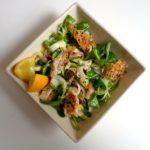 A salad of smoked fish makes a delightful lunch as the days grow cooler. In the salad pictured here, I used smoked mackerel, which is sold in France covered in crushed black pepper. Its tawny hues contrast nicely with the deep green of lamb’s lettuce and pale Belgian endive. Other options for the fish include smoked trout, smoked salmon or the perennial French favorite, smoked herring, a bistro classic that is popular here in the winter months.
A salad of smoked fish makes a delightful lunch as the days grow cooler. In the salad pictured here, I used smoked mackerel, which is sold in France covered in crushed black pepper. Its tawny hues contrast nicely with the deep green of lamb’s lettuce and pale Belgian endive. Other options for the fish include smoked trout, smoked salmon or the perennial French favorite, smoked herring, a bistro classic that is popular here in the winter months.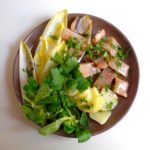 oil. In my salad version, the herring is chopped and accompanied by greens. It’s a bit lighter and brighter, and can make a proper lunchtime meal.
oil. In my salad version, the herring is chopped and accompanied by greens. It’s a bit lighter and brighter, and can make a proper lunchtime meal.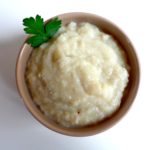 When the days draw shorter, a warming dish like finocchio purée provides comfort. Yet it is not one of your heavy comfort foods. Light, with a delicate flavor, this purée marries well with all sorts of autumn dishes — meat, fish or poultry, grilled or lovingly simmered — and makes a spectacular pairing with game. It also makes a fine addition to a vegetarian meal. And the beauty is that the finocchio growing season is … all year round.
When the days draw shorter, a warming dish like finocchio purée provides comfort. Yet it is not one of your heavy comfort foods. Light, with a delicate flavor, this purée marries well with all sorts of autumn dishes — meat, fish or poultry, grilled or lovingly simmered — and makes a spectacular pairing with game. It also makes a fine addition to a vegetarian meal. And the beauty is that the finocchio growing season is … all year round. Sauté d’agneau is one of those great French classics that used to feature frequently on bistro menus, especially when the weather turned cool. These days this succulent lamb dish is harder to find in Paris restaurants, where current culinary fashion favors small plates of designer food. Nonetheless, it has been a personal favorite since I first tasted it many years ago at l’Entrepôt, an airy, veranda-style restaurant tucked away behind Montparnasse.
Sauté d’agneau is one of those great French classics that used to feature frequently on bistro menus, especially when the weather turned cool. These days this succulent lamb dish is harder to find in Paris restaurants, where current culinary fashion favors small plates of designer food. Nonetheless, it has been a personal favorite since I first tasted it many years ago at l’Entrepôt, an airy, veranda-style restaurant tucked away behind Montparnasse. This tangy omelet hails from the French Basque country and is filled with the regional veggie dish known as piperade, a mixture of green peppers, tomatoes, onion, garlic and pepper slowly sautéed in olive oil until it reaches aromatic, spicy perfection. This is a good time of year to try it out, when peppers and tomatoes are at their prime. Unsuprisingly, the omelet is also known as omelette à la piperade. It makes a nice lunch or a light supper.
This tangy omelet hails from the French Basque country and is filled with the regional veggie dish known as piperade, a mixture of green peppers, tomatoes, onion, garlic and pepper slowly sautéed in olive oil until it reaches aromatic, spicy perfection. This is a good time of year to try it out, when peppers and tomatoes are at their prime. Unsuprisingly, the omelet is also known as omelette à la piperade. It makes a nice lunch or a light supper. This is high season for French tomato tart, and the good news is that producing one is as easy as, well, pie. But there’s a secret ingredient without which this tart would lose its special French identity. No, I’m not talking about the garlic, thyme and olive oil that give French tomato tart the flavors of Provence. The secret ingredient from which the tart gets its zing is … Dijon mustard. Now as you may imagine there are many variations.
This is high season for French tomato tart, and the good news is that producing one is as easy as, well, pie. But there’s a secret ingredient without which this tart would lose its special French identity. No, I’m not talking about the garlic, thyme and olive oil that give French tomato tart the flavors of Provence. The secret ingredient from which the tart gets its zing is … Dijon mustard. Now as you may imagine there are many variations. Fresh summer fruit piled into dessert cups with a splash of crème de cassis makes a lovely way to end a meal. Add a smattering of mint leaves, and you have a dish that is both sophisticated and simple to prepare. You can use whatever soft fruit happens to be available. For example, nectarines, fresh figs, raspberries and blueberries, as shown in the photo. Earlier this summer I used cherries, blueberries and peaches, and won applause.
Fresh summer fruit piled into dessert cups with a splash of crème de cassis makes a lovely way to end a meal. Add a smattering of mint leaves, and you have a dish that is both sophisticated and simple to prepare. You can use whatever soft fruit happens to be available. For example, nectarines, fresh figs, raspberries and blueberries, as shown in the photo. Earlier this summer I used cherries, blueberries and peaches, and won applause.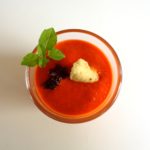 This little gem of a recipe for chilled red pepper soup was inspired by a recent visit to one of my favorite Paris restaurants, Zebulon, where it was served as a surprise “palate teaser”, with a tiny savory biscuit and finely chopped black olives on top. There were only a few spoonfuls in the tiny soup cups, but — wow — did they pack a punch. The flavor is reminiscent of gazpacho, but more sophisticated. When I got home, I had to try to make it.
This little gem of a recipe for chilled red pepper soup was inspired by a recent visit to one of my favorite Paris restaurants, Zebulon, where it was served as a surprise “palate teaser”, with a tiny savory biscuit and finely chopped black olives on top. There were only a few spoonfuls in the tiny soup cups, but — wow — did they pack a punch. The flavor is reminiscent of gazpacho, but more sophisticated. When I got home, I had to try to make it. This is the time of year when I’m either in the country stoking up the barbecue or dreaming of being there. At the moment, as Paris swelters through its second heatwave of this young summer, I’m still dreaming. But that won’t prevent me from making grilled chicken on wooden skewers — au contraire. It’s a perfect dish for hot summer weather, even at home, as it can be prepared on the stovetop in a matter of minutes with minimal fuss.
This is the time of year when I’m either in the country stoking up the barbecue or dreaming of being there. At the moment, as Paris swelters through its second heatwave of this young summer, I’m still dreaming. But that won’t prevent me from making grilled chicken on wooden skewers — au contraire. It’s a perfect dish for hot summer weather, even at home, as it can be prepared on the stovetop in a matter of minutes with minimal fuss.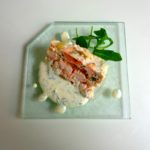 A light start to a meal of a warm summer’s evening is a fish terrine — in this case, a terrine of salmon, shrimp and sea scallops, with a sauce flavored with curry and dill. For years I have enjoyed the fish terrines on offer at Parisian food shops, where they beckon elegantly in multicolor slices. But I only recently began making them. And the good news is that it’s fun. It requires a French technique known as bain-marie.
A light start to a meal of a warm summer’s evening is a fish terrine — in this case, a terrine of salmon, shrimp and sea scallops, with a sauce flavored with curry and dill. For years I have enjoyed the fish terrines on offer at Parisian food shops, where they beckon elegantly in multicolor slices. But I only recently began making them. And the good news is that it’s fun. It requires a French technique known as bain-marie.

